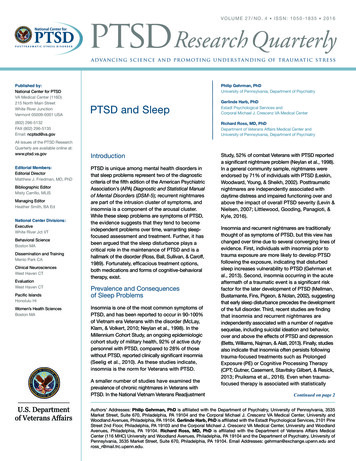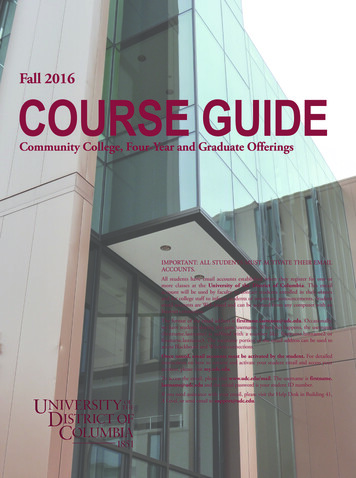
Transcription
V O L U M E 2 7 / N O . 4 I S S N : 1 0 5 0 -1 8 3 5 2 0 1 6Research Quarterlyadvancing science and pr omoting unders tanding of traum atic stressPublished by:National Center for PTSDVA Medical Center (116D)215 North Main StreetWhite River JunctionVermont 05009-0001 USAPhilip Gehrman, PhDUniversity of Pennsylvania, Department of PsychiatryPTSD and Sleep(802) 296-5132FAX (802) 296-5135Email: ncptsd@va.govAll issues of the PTSD ResearchQuarterly are available online at:www.ptsd.va.govEditorial Members:Editorial DirectorMatthew J. Friedman, MD, PhDBibliographic EditorMisty Carrillo, MLISManaging EditorHeather Smith, BA EdNational Center Divisions:ExecutiveWhite River Jct VTBehavioral ScienceBoston MADissemination and TrainingMenlo Park CAClinical NeurosciencesWest Haven CTEvaluationWest Haven CTPacific IslandsHonolulu HIWomen’s Health SciencesBoston MAGerlinde Harb, PhDEstadt Psychological Services andCorporal Michael J. Crescenz VA Medical CenterRichard Ross, MD, PhDDepartment of Veterans Affairs Medical Center andUniversity of Pennsylvania, Department of PsychiatryIntroductionPTSD is unique among mental health disorders inthat sleep problems represent two of the diagnosticcriteria of the fifth edition of the American PsychiatricAssociation’s (APA) Diagnostic and Statistical Manualof Mental Disorders (DSM-5); recurrent nightmaresare part of the intrusion cluster of symptoms, andinsomnia is a component of the arousal cluster.While these sleep problems are symptoms of PTSD,the evidence suggests that they tend to becomeindependent problems over time, warranting sleepfocused assessment and treatment. Further, it hasbeen argued that the sleep disturbance plays acritical role in the maintenance of PTSD and is ahallmark of the disorder (Ross, Ball, Sullivan, & Caroff,1989). Fortunately, efficacious treatment options,both medications and forms of cognitive-behavioraltherapy, exist.Prevalence and Consequencesof Sleep ProblemsInsomnia is one of the most common symptoms ofPTSD, and has been reported to occur in 90-100%of Vietnam era Veterans with the disorder (McLay,Klam, & Volkert, 2010; Neylan et al., 1998). In theMillennium Cohort Study, an ongoing epidemiologiccohort study of military health, 92% of active dutypersonnel with PTSD, compared to 28% of thosewithout PTSD, reported clinically significant insomnia(Seelig et al., 2010). As these studies indicate,insomnia is the norm for Veterans with PTSD.A smaller number of studies have examined theprevalence of chronic nightmares in Veterans withPTSD. In the National Vietnam Veterans ReadjustmentStudy, 52% of combat Veterans with PTSD reporteda significant nightmare problem (Neylan et al., 1998).In a general community sample, nightmares wereendorsed by 71% of individuals with PTSD (Leskin,Woodward, Young, & Sheikh, 2002). Posttraumaticnightmares are independently associated withdaytime distress and impaired functioning over andabove the impact of overall PTSD severity (Levin &Nielsen, 2007; Littlewood, Gooding, Panagioti, &Kyle, 2016).Insomnia and recurrent nightmares are traditionallythought of as symptoms of PTSD, but this view haschanged over time due to several converging lines ofevidence. First, individuals with insomnia prior totrauma exposure are more likely to develop PTSDfollowing the exposure, indicating that disturbedsleep increases vulnerability to PTSD (Gehrman etal., 2013). Second, insomnia occurring in the acuteaftermath of a traumatic event is a significant riskfactor for the later development of PTSD (Mellman,Bustamante, Fins, Pigeon, & Nolan, 2002), suggestingthat early sleep disturbance precedes the developmentof the full disorder. Third, recent studies are findingthat insomnia and recurrent nightmares areindependently associated with a number of negativesequelae, including suicidal ideation and behavior,over and above the effects of PTSD and depression(Betts, Williams, Najman, & Alati, 2013). Finally, studiesalso indicate that insomnia often persists followingtrauma-focused treatments such as ProlongedExposure (PE) or Cognitive Processing Therapy(CPT; Gutner, Casement, Stavitsky Gilbert, & Resick,2013; Pruiksma et al., 2016). Even when traumafocused therapy is associated with statisticallyContinued on page 2Authors’ Addresses: Philip Gehrman, PhD is affiliated with the Department of Psychiatry, University of Pennsylvania, 3535Market Street, Suite 670, Philadelphia, PA 19104 and the Corporal Michael J. Crescenz VA Medical Center, University andWoodland Avenues, Philadelphia, PA 19104. Gerlinde Harb, PhD is affiliated with the Estadt Psychological Services, 2101 PineStreet 2nd Floor, Philadelphia, PA 19103 and the Corporal Michael J. Crescenz VA Medical Center, University and WoodlandAvenues, Philadelphia, PA 19104. Richard Ross, MD, PhD is affiliated with the Department of Veterans Affairs MedicalCenter (116 MHC) University and Woodland Avenues, Philadelphia, PA 19104 and the Department of Psychiatry, University ofPennsylvania, 3535 Market Street, Suite 670, Philadelphia, PA 19104. Email Addresses: gehrman@exchange.upenn.edu andross r@mail.trc.upenn.edu.
Continued from coversignificant improvements in sleep, effect sizes are small and notclinically significant. Like insomnia, nightmares frequently do notimprove with trauma-focused treatment although the degree ofimprovement is larger than for insomnia (Belleville, Guay, & Marchand,2011). If the sleep disturbance were purely a symptom of PTSD itshould resolve following successful treatment of the overall disorder.Insomnia and, to a lesser extent, nightmares are now thought of ascomorbid problems that develop a degree of independence overtime and warrant targeted treatment (see below).It is important to be aware that insomnia and recurrent nightmaresare often not the only sleep disorders that individuals with PTSDexperience. There is growing evidence that this population alsosuffers from obstructive sleep apnea (OSA), a sleep-related breathingdisorder, more often than the general population (Jaoude, Vermont,Porhomayon, & El-Solh, 2015) although not all studies have found anassociation with PTSD (Mysliwiec et al., 2015). OSA involves repetitiveblockage of the airway that leads to fragmented sleep and reducedflow of oxygen to the brain. Given the impact of OSA on sleep, it isnot surprising that studies are finding that treatment of comorbidapnea can improve not only sleep symptoms, but overall PTSDseverity as well (Tamanna, Parker, Lyons, & Ullah, 2014). The primarytreatment for OSA is continuous positive airway pressure (CPAP), inwhich a mask is worn at night that delivers pressurized air to keepthe airway open. In some studies, patients with PTSD have loweradherence to CPAP (Collen, Lettieri, & Hoffman, 2012). A small bodyof evidence is beginning to show that parasomnias other thannightmares, such as sleep walking and rapid eye movement (REM)behavior disorder, are also more common in patients with PTSD, butit is not clear to what extent these represent comorbid disorders orare directly caused by trauma-related mechanisms (Mysliwiec et al.,2014). What is clear is that screening for sleep disorders beyondinsomnia and recurrent nightmares needs to be routinely incorporatedin the clinical assessment of PTSD.Treatment of Sleep Problems in PTSDTwo primary approaches to treating sleep problems exist in PTSD,pharmacotherapy, and psychotherapy. Each has demonstratedefficacy when compared to placebo or control conditions, but littleis known about the efficacy of using both approaches concurrently.The preferred treatment approach for insomnia, when available, iscognitive behavioral therapy.PharmacotherapyOne approach to the treatment of insomnia in the context of PTSD isthe use of hypnotic medications and other medications with sedativeside effects. However, there are very few clinical trials examining theefficacy of these medications in individuals with PTSD. Of note, somemedications used to treat PTSD can cause or exacerbate insomnia(e.g., selective serotonin reuptake inhibitors [SSRIs]). In terms ofnightmares, the main option available is prazosin, an alpha-adrenergicreceptor antagonist that has been used for the treatment ofhypertension. Prazosin has been found to be effective for reducingnightmares and improving sleep in Veterans with PTSD in multipletrials (Khachatryan, Groll, Booij, Sepehry, & Schütz, 2016; Petrakiset al., 2016; Raskind et al., 2007; Raskind et al., 2013). However, therigorous, recently completed large US Department of Veterans Affairs(VA) multisite VA Cooperative Study found no advantage of prazosincompared to placebo in reducing the nightmare disturbance andimproving sleep (VA Office of Research and Development, 2016).PAGE 2Evidence also exists that shows patients frequently discontinueprazosin use prematurely (Alexander, Lund, Bernardy, Christopher, &Friedman, 2015). Raskind et al. (2016) have suggested that higherstanding blood pressure, an indicator of noradrenergic stimulation ofalpha-1 adrenoceptors, may be a useful biomarker for identifying asubgroup of individuals with combat-related PTSD likely to benefitfrom prazosin. Of note, prazosin is not sedating so it does notshorten sleep onset latency although it does promote REM sleepcontinuity. The antihistaminergic drug hydroxyzine was found todecrease nightmares and improve sleep in one placebo-controlledtrial (Ahmadpanah et al., 2014). Hertzberg, Feldman, Beckham, andDavidson (1996) provided some evidence for the usefulness oftrazodone in treating PTSD, including the sleep disturbance, butthere has been no large randomized controlled trial (RCT). Althoughno benzodiazepine has been studied in such a trial, the nonbenzodiazepine drug eszopiclone, which acts at the benzodiazepinereceptor, showed efficacy for treating PTSD and the associatedsleep disturbance in a small RCT (Pollack et al., 2011). Regarding theatypical antipsychotic drugs, adjunctive risperidone had modestefficacy in improving sleep quality in Veterans with PTSD (Krystal etal., 2016) and, in a RCT, quetiapine monotherapy was shown toreduce symptoms of military-related PTSD, with an unclear effect onsleep quality specifically (Villarreal et al., 2016).Cognitive Behavioral TreatmentsThe preferred treatment approach for insomnia is cognitive behavioraltreatment for insomnia (CBT-I), a series of strategies focused onstimulus control, sleep restriction, de-arousal techniques, sleephygiene, and cognitive restructuring. Treatment length is typically 6sessions but ranges from 4-8 sessions for most patients. CBT-I hasdemonstrated efficacy in patients with primary insomnia in manyrandomized trials and several meta-analyses. CBT-I has demonstratedsustained improvement in insomnia symptoms on follow-upassessments ranging from 1 to 3 years. The durability of treatmenteffects is a clear advantage over long-term pharmacotherapy, as arethe lower risk of side effects and the absence of drug interactions.A recent randomized trial in Veterans with PTSD found that CBT-I ledto greater improvements in sleep and reductions in disruptive sleeprelated behaviors than placebo, demonstrating the efficacy of CBT-I inthis population (Ho, Chan, & Tang, 2016; Talbot, Hairston, Eidelman,Gruber, & Harvey, 2009). CBT-I may also be a good first step prior tobeginning trauma-focused therapy (Baddeley & Gros, 2013).A psychotherapeutic (CBT) approach to treating nightmares is imageryrehearsal therapy (IR), which is also referred to as nightmarere-scripting because it entails choosing a recurrent nightmare andfinding a way to change (i.e., re-script) the content in a way thatmakes it less intense or distressing. There are several trials of IR withpositive outcomes in civilian populations (e.g. Krakow et al., 2001)but a large, randomized trial in Vietnam Veterans with PTSD failed todemonstrate clear efficacy (Cook et al., 2010). Recent systematicreviews found that most of the clinical trials to date were of mixedscientific rigor (Casement & Swanson, 2012; Harb et al., 2013).Additional studies are needed before conclusions can be maderegarding the efficacy of this treatment approach in Veteran andnon-Veteran populations, as well as comparing IR to prazosin(Seda, Sanchez-Ortuno, Welsh, Halbower, & Edinger, 2015).Group TreatmentBoth CBT-I and IR can be delivered individually as well as in a groupformat; also, CBT-I or components of CBT-I can be added to IR. Atypical group consists of 6-8 individuals and meets weekly for 6P T S D R E S E A R C H Q U A R T E R LY
weeks (longer if CBT-I and IR are both delivered) for 90 minutes pervisit. The material is the same as in the individual treatments, withthe added element of hearing the experiences of other Veterans withPTSD. A pilot study of combined CBT-I and IR delivered in a groupformat found significant improvements in both insomnia andnightmares (Swanson, Favorite, Horin, & Arnedt, 2009), althoughmost of the improvement in nightmares occurred prior to theintroduction of IR content. This suggests that, at least for someindividuals, CBT-I alone can lead to improvements in nightmares.SummaryIn summary, sleep problems are highly prevalent in Veterans withPTSD. Beyond being a symptom of PTSD, the sleep problemsusually evolve into independent disorders that are also associatedwith significant distress and impairment, including an increased riskfor suicidality. Treatment options include both pharmacologic andcognitive behavioral approaches, and both have demonstratedefficacy for insomnia and recurrent nightmares, although the resultsfor nightmares are more mixed. Sleep-focused assessment andtreatment should be established as standard care for Veteranswith PTSD.FEATURED ARTICLESBelleville, G., Guay, S., & Marchand, A. (2011). Persistence ofsleep disturbances following cognitive-behavior therapy forposttraumatic stress disorder. Journal of Psychosomatic Research,70, 318-327. doi:10.1016/j.jpsychores.2010.09.022 Objectives: Theobjectives of the present study were (1) to assess the impact ofcognitive-behavior therapy (CBT) for posttraumatic stress disorder(PTSD) on associated sleep disturbances and (2) to explore thecorrelates of persistent sleep difficulties in terms of anxiety anddepression symptoms and perceived health. Method: Fifty-fiveindividuals with PTSD were administered a series of assessmentsdesigned to evaluate sleep, PTSD symptoms, symptoms of anxietyand depression, and perceived health before and after individualCBT for PTSD and at 6-month follow-up. Results: Significantimprovements were observed on sleep quality, sleep onset latency,sleep efficiency, and sleep disturbances. These changes were notfully maintained after 6 months, and 70% of people who reportedbaseline sleep difficulties (Pittsburgh Sleep Quality Index 5) stillreported significant problems with sleep after treatment. Persistentsleep difficulties were associated with more severe posttraumatic,anxious, and depressive symptoms as well as poorer health.Conclusion: Although CBT for PTSD had a favorable impact on sleep,the majority of participants suffered from residual sleep difficulties.Individuals with persistent sleep difficulties posttreatment mayexperience more residual posttraumatic, depression, and anxietysymptoms and poorer mental and physical health than those whodo not report sleep problems posttreatment. Further research in thisarea will allow clinicians to treat sleep problems in these individualsmore effectively.Betts, K. S., Williams, G. M., Najman, J. M., & Alati, R. (2013). The roleof sleep disturbance in the relationship between post-traumaticstress disorder and suicidal ideation. Journal of Anxiety Disorders,27, 735-741. doi:10.1016/j.janxdis.2013.09.011 We tested if the riskof suicidal ideation in individuals with PTSD symptoms was dependenton comorbid sleep disturbance. Our cross-sectional sample includedVOLUME 27/NO. 4 2016FEATURED ARTICLES continued2465 participants with complete data from the 21 year follow-up ofthe Mater University Study of Pregnancy (MUSP), a birth cohort studyof young Australians. Using structural equation modelling with indirectpathways we found that 12 month PTSD symptoms did not directlypredict suicidal ideation at 21 when adjusting for major depressionsymptoms, polyvictimization and gender. However, PTSD symptomshad an indirect effect on suicidal ideation via past-month sleepdisturbance. Our results suggest that increased suicidal ideation inthose with PTSD may result from the fact that PTSD sufferers oftenexhibit other comorbid psychiatric conditions which are themselvesknown to predict suicidal behaviours. Sleep disturbance may betargeted in those who experience PTSD to help prevent suicidal ideation.Cook, J. M., Harb, G. C., Gehrman, P. R., Cary, M. S., Gamble, G. M.,Forbes, D., & Ross, R. J. (2010). Imagery rehearsal for posttraumaticnightmares: A randomized controlled trial. Journal of TraumaticStress, 23, 553-563. doi:10.1002/jts.20569 One hundred twenty-fourmale Vietnam War veterans with chronic, severe posttraumatic stressdisorder (PTSD) were randomly assigned to imagery rehearsal (n 61)or a credible active comparison condition (n 63) for the treatmentof combat-related nightmares. There was pre-post change in overallsleep quality and PTSD symptoms for both groups, but not in nightmarefrequency. Intent-to-treat analyses showed that veterans who receivedimagery rehearsal had not improved significantly more than veteransin the comparison condition for the primary outcomes (nightmarefrequency and sleep quality), or for a number of secondary outcomes,including PTSD. Six sessions of imagery rehearsal delivered in groupformat did not produce substantive improvement in Vietnam Warveterans with chronic, severe PTSD. Possible explanations for findingsare discussed.Gehrman, P., Seelig, A. D., Jacobson, I. G., Boyko, E. J., Hooper, T. I.,Gackstetter, G. D., . . . Smith, T. C. (2013). Predeployment sleepduration and insomnia symptoms as risk factors for new-onsetmental health disorders following military deployment. Sleep, 36,1009-1018. doi:10.5665/sleep.2798 Study Objectives: To evaluatepredeployment sleep duration and insomnia symptoms in relation tothe development of mental health symptoms. Design: Longitudinalcohort study. Setting: The Millennium Cohort Study survey is administeredvia a secure website or US mail. Participants: Data were from 15,204participants who completed their first deployment between thesubmissions of 2 consecutive Millennium Cohort questionnaires(2001-2008). Interventions: N/A. Measurements and Results: Usingself-reported data from the Millennium Cohort Study we evaluatedthe association of predeployment sleep duration and insomniasymptoms on the development of new-onset mental disorders amongdeployers. Multivariable logistic regression was used to estimate theodds of developing posttraumatic stress disorder (PTSD), depression,and anxiety, while adjusting for relevant covariates including combatrelated trauma. The study outcomes were assessed using validatedinstruments, including the PTSD checklist-civilian version, and thePRIME-MD Patient Health Questionnaire. We identified 522 peoplewith new-onset PTSD, 151 with anxiety, and 303 with depressionfollowing deployment. In adjusted models, combat-related traumaand predeployment insomnia symptoms were significantly associatedwith higher odds of developing posttraumatic stress disorder,depression, and anxiety postdeployment. Conclusions: Sleepcharacteristics, especially insomnia symptoms, are related to thedevelopment of mental disorders following military deployments.PAGE 3
FEATURED ARTICLES continuedAssessment of insomnia symptoms predeployment may help tobetter identify those at highest risk for subsequent adverse mentalhealth outcomes.Harb, G. C., Phelps, A. J., Forbes, D., Ross, R. J., Gehrman, P. R.,& Cook, J. M. (2013). A critical review of the evidence base ofimagery rehearsal for posttraumatic nightmares: Pointing theway for future research. Journal of Traumatic Stress, 26, 570-579.doi:10.1002/jts.21854 In this article, the authors provide informationon key characteristics of imagery rehearsal treatment protocolsand examine the quality of reporting of randomized controlled anduncontrolled trials of imagery rehearsal for treating posttraumaticnightmares. Using a reliable and valid scale, two independentpsychologists rated 16 trials. Most reports provided insufficientinformation on a range of variables including the definition of treatmentdelivery (e.g., therapist supervision, treatment fidelity), description ofthe participant sample, data analysis (e.g., determination of samplesize), and treatment assignment (e.g., randomization procedures).Low methodological quality and poor reporting can lead to inflationof estimates of treatment effects and inadequately substantiatedconclusions, such as inflated effect sizes in meta-analytic studies.Numerous imagery rehearsal protocols exist, but in some cases aregiven different names and tested in pilot studies, slowing progressionin the field. Randomized controlled trials of imagery rehearsal withcredible comparison conditions, examination of predictors of dropoutand outcome, as well as dismantling studies of imagery rehearsaltreatment components are needed.Hertzberg, M. A., Feldman, M. E., Beckham, J. C., & Davidson, J. R. T.(1996). Trial of trazodone for posttraumatic stress disorderusing a multiple baseline group design. Journal of ClinicalPsychopharmacology, 16, 294-298. Six patients with combat-relatedposttraumatic stress disorder (PTSD) entered a multiple-baseline trialof trazodone, beginning with 50 mg/day and increasing to 400 mg/dayuntil response was maximal. Total Clinician-Administered PTSD Scalescores decreased from a mean of 92 at baseline to 79 at end point,and self-reported PTSD symptoms as measured by the DavidsonTrauma Scale paralleled these results (mean of 102 at baseline to 88 atend point). Based on clinician global improvement scores, four patientswere rated as much improved and two were rated to be minimallyimproved. Improvement in social and occupational functioning, anddepression was minimal. Available follow-up scores for PTSD symptomsindicated that gains were maintained. Sleep was the first symptomto improve at 2 to 3 months. No dropouts during the treatment periodoccurred, and reported side effects were quite low. These preliminarydata suggest that trazodone may be effective in reducing the threeprimary clusters of symptoms of PTSD. These findings should beconfirmed by using a larger sample in a double-blind, placebocontrolled study.Jaoude, P., Vermont, L. N., Porhomayon, J., & El-Solh, A. A. (2015).Sleep-disordered breathing in patients with post-traumatic stressdisorder. Annals of the American Thoracic Society, 12, 259-268.doi:10.1513/AnnalsATS.201407-299FR Post-traumatic stress disorder(PTSD) and sleep-disordered breathing (SDB) are shared by manypatients. They both affect sleep and the quality of life of affectedsubjects. A critical review of the literature supports an associationbetween the two disorders in both combat-related and non–combatrelated PTSD. The exact mechanism linking PTSD and SDB is notPAGE 4fully understood. A complex interplay between sleep fragmentationand neuroendocrine pathways is suggested. The overlap of symptomsbetween PTSD and SDB raises diagnostic challenges that may requirea novel approach in the methods used to diagnose the coexistingdisorders. Similar therapeutic challenges face patients and providerswhen treating concomitant PTSD and SDB. Although continuouspositive airway pressure therapy imparts a mitigating effect on PTSDsymptomatology, lack of both acceptance and adherence are common.Future research should focus on ways to improve adherence tocontinuous positive airway pressure therapy and on the use ofalternative therapeutic methods for treating SDB in patients with PTSD.Krakow, B., Hollifield, M., Johnston, L., Koss, M., Schrader, R.,Warner, T. D., . . . Prince, H. (2001). Imagery rehearsal therapyfor chronic nightmares in sexual assault survivors withposttraumatic stress disorder: A randomized controlled trial.Journal of the American Medical Association, 286, 537-545.doi:10.1001/jama.286.5.537 Context: Chronic nightmares occurfrequently in patients with posttraumatic stress disorder (PTSD) butare not usually a primary target of treatment. Objective: To determineif treating chronic nightmares with imagery rehearsal therapy (IRT)reduces the frequency of disturbing dreams, improves sleep quality,and decreases PTSD symptom severity. Design, Setting, andParticipants: Randomized controlled trial conducted from 1995 to1999 among 168 women in New Mexico; 95% had moderate-tosevere PTSD, 97% had experienced rape or other sexual assault,77% reported life-threatening sexual assault, and 58% reportedrepeated exposure to sexual abuse in childhood or adolescence.Intervention: Participants were randomized to receive treatment(n 88) or to the wait-list control group (n 80). The treatment groupreceived IRT in 3 sessions; controls received no additional intervention,but continued any ongoing treatment. Main Outcome Measures: Scoreson the Nightmare Frequency Questionnaire (NFQ), Pittsburgh SleepQuality Index (PSQI), PTSD Symptom Scale (PSS), and ClinicianAdministered PTSD Scale (CAPS) at 3- and 6-month follow-up.Results: A total of 114 participants completed follow-up at 3 and/or6 months. Comparing baseline to follow-up (n 97-114), treatmentsignificantly reduced nights per week with nightmares (Cohen d 1.24;P .001) and number of nightmares per week (Cohen d 0.85; P .001)on the NFQ and improved sleep (on the PSQI, Cohen d 0.67;P .001) and PTSD symptoms (on the PSS, Cohen d 1.00; P .001and on the CAPS, Cohen d 1.53; P .001). Control participantsshowed small, nonsignificant improvements for the same measures(mean Cohen d 0.21). In a 3-point analysis (n 66-77), improvementsoccurred in the treatment group at 3-month follow-up (treatment vscontrol group, Cohen d 1.15 vs 0.07 for nights per week withnightmares; 0.95 vs 0.06 for nightmares per week; 0.77 vs 0.31 onthe PSQI, and 1.06 vs 0.31 on the PSS) and were sustained withoutfurther intervention or contact between 3 and 6 months. An intentto-treat analysis (n 168) confirmed significant differences betweentreatment and control groups for nightmares, sleep, and PTSD(all P .02) with moderate effect sizes for treatment (mean Cohen d 0.60)and small effect sizes for controls (mean Cohen d 0.14). Posttraumaticstress symptoms decreased by at least 1 level of clinical severityin 65% of the treatment group compared with symptoms worseningor not changing in 69% of controls (χ 21 12.80; P .001).Conclusions: Imagery rehearsal therapy is a brief, well-toleratedtreatment that appears to decrease chronic nightmares, improvesleep quality, and decrease PTSD symptom severity.P T S D R E S E A R C H Q U A R T E R LY
FEATURED ARTICLES continuedLeskin, G. A., Woodward, S. H., Young, H. E., & Sheikh, J. I. (2002).Effects of comorbid diagnoses on sleep disturbance in PTSD.Journal of Psychiatric Research, 36, 449-452. doi:10.1016/S00223956(02)00025-0 Objective: Patients with post-traumatic stressdisorder (PTSD) are frequently diagnosed with other psychiatriccomorbid conditions. This study tested the hypothesis that PTSDpatients suffer a greater proportion of sleep problems according tocomorbid diagnoses. Method: National Comorbidity Survey (NCS)data from 591 individuals diagnosed with PTSD were analyzed.Revised versions of the Diagnostic Interview Schedule and CompositeInternational Diagnostic Interview were administered to a representativesample of males and females. Groups consisted of patients diagnosedwith lifetime PTSD and with current comorbid panic disorder, majordepressive disorder, generalized anxiety disorder, and alcoholdependence. Results: Patients diagnosed with PTSD/panic disorderreported a significantly greater proportion of nightmare complaints(96%) and insomnia (100%) compared with the other comorbid groups.Conclusions: A greater proportion of PTSD patients with comorbidpanic disorder complain of sleep-related problems than other comorbidgroups. This effect appears unique to panic, rather than other generalanxiety disorder or depression. Prospective sleep studies are neededto differentiate the role of sleep in PTSD and PD, as well as toexamine the role of psychiatric comorbidity in worsening sleep inPTSD patients.Levin, R., & Nielsen, T. A. (2007). Disturbed dreaming, posttraumaticstress disorder, and affect distress: A review and neurocognitivemodel. Psychological Bulletin, 133, 482-528. doi:10.1037/00332909.133.3.482 Nightmares are common, occurring weekly in 4%-10%of the population, and are associated with female gender, youngerage, increased stress, psychopathology, and dispositional traits.Nightmare pathogenesis remains unexplained, as do differencesbetween nontraumatic and posttraumatic nightmares (for those withor without posttraumatic stress disorder) and relations with wakingfunctioning. No models adequately explain nightmares nor have theybeen reconciled with recent developments in cognitive neuroscience,fear acquisition, and emotional memory. The authors review therecent literature and propose a conceptual framework for understandinga spectrum of dysphoric dreaming. Central to this is the notionthat variations in nightmare prevalence, frequency, severity, andpsychopathological comorbidity reflect the influence of both affectload, a consequence of daily variations in emotional pressure, andaffect distress, a disposition to experience events with distressing,highly reactive emotions. In a cross-state, multilevel model of dreamfunction and nightmare production, the authors integrate findings onemotional memory structures and the brain correlates of emotion.Mellman, T. A., Bustamante, V., Fins, A. I., Pigeon, W. R., & Nolan, B.(2002). REM sleep and the early development of posttraumaticstress disorder. Ame
related behaviors than placebo, demonstrating the efficacy of CBT-I in this population (Ho, Chan, & Tang, 2016; Talbot, Hairston, Eidelman, Gruber, & Harvey, 2009). CBT-I may also be a good first step prior to beginning trauma-focused therapy (Baddeley & Gros, 2013). A psychotherapeutic (CBT) approach to treating nightmares is imagery











